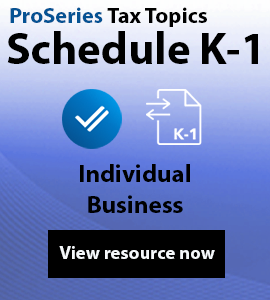- Topics
- Training
- Community
- Product Help
- Industry Discussions
- User Groups
- Discover
- Resources
- Intuit Accountants Community
- :
- ProSeries Tax
- :
- ProSeries Tax Discussions
- :
- S Corp that has a 1099-NEC and other income
S Corp that has a 1099-NEC and other income
- Mark Topic as New
- Mark Topic as Read
- Float this Topic for Current User
- Bookmark
- Subscribe
- Printer Friendly Page
- Mark as New
- Bookmark
- Subscribe
- Permalink
- Report Inappropriate Content
I am seeking tax expert assistance with an S Corp tax return that involves reporting three 1099s on the 1040 and additional income on the 1120. What is the proper method for separating the client's expenses? The client is a contractor who earns income from multiple sources in a single day. While I did not prepare their books, I have a profit and loss statement and bank statements. In additional to confirm the 1099-NEC goes on the 1040? CorectPlease provide assistance.
- Mark as New
- Bookmark
- Subscribe
- Permalink
- Report Inappropriate Content
Your post is very confusing.
If on the 1120S you can just add the 3 1099's together, if that's 100% of their revenue and enter it on Line 1. If there are sources of revenue beyond the 1099's then you just add that to Line 1 also.
You don't need to show 1099-NEC's on an 1120S. You just need to understand the implications if the total of the 1099's is greater than the total revenue shown on the 1120S. Then a "theoretical" matching problem could occur.
The 1040 doesn't show any of this. It just shows the K-1 apportioned flow-throughs.
- Mark as New
- Bookmark
- Subscribe
- Permalink
- Report Inappropriate Content
Not totally understanding what you are asking, but if your client is a contractor DBA S-Corp then all 1099NEC should have been issued to S-Corp EIN, and S-Corp should be issuing your client a W2, and a K1
- Mark as New
- Bookmark
- Subscribe
- Permalink
- Report Inappropriate Content
Ok, got it!! Thank you!
- Mark as New
- Bookmark
- Subscribe
- Permalink
- Report Inappropriate Content
If the 1099-NECs are issued to the individual you should ask him why.
The more I know the more I don’t know.
- Mark as New
- Bookmark
- Subscribe
- Permalink
- Report Inappropriate Content
Stick to one thread.
The more I know the more I don’t know.
- Mark as New
- Bookmark
- Subscribe
- Permalink
- Report Inappropriate Content
1099-NEC is an informational form. It is only required to be issued when the payment for service is between businesses, and when it exceeds $600 or more in the calendar year, and only issued to certain entity types (not C Corp, not S Corp). Your client working for his S Corp is supposed to be paid through payroll. The customers are paying the Corporation, not your client. Your client is supposed to provide a W9 to those businesses, with the information of the S Corp on it, and that way, they won't create a 1099-NEC for that work. Your client also would issue a 1099-NEC to his own subcontractors if all of this applies, that's why you see this as a question on the tax form. If the payments are through a "settlement agent" such as credit card or PayPal or Venmo, there is not a 1099-NEC issued, because the payment now falls under the 1099-K rules for the payment entity.
That's also why your comment of, "who earns income from multiple sources in a single day" has no bearing on the Form 1040. This is what businesses do, they have lots of sources of income. That's part of the Form 1120-S (not 1120). That's their operation.
You asked about, "separating the client's expenses" and there are No Client expenses. They are working for the corporation, so there are corporate expenses that need to be tracked, handled and reported appropriately to those regulations. This is not like a sole proprietorship. If your client is a major shareholder in the S Corp, there also are limitations you need to know.
And the 1120-S had a filing deadline of March 15. If they got a K-1, you don't also prepare their personal taxes using any of the business details. Again, it's not the taxpayer's personal activity. A corporation is its own entity.
"to confirm the 1099-NEC goes on the 1040? Corect"
Never. A 1099-NEC is evidence of business activity. A taxpayer is supposed to track everything about their business. If all the work they do is for private individuals, a 1099-NEC would never even be issued. That doesn't mean they ignore that this is a business for tax filing purposes. You file the business info, not the informational form. But you should use that to confirm they are reasonably reporting all the business info to you, of course.
Don't yell at us; we're volunteers
- Mark as New
- Bookmark
- Subscribe
- Permalink
- Report Inappropriate Content
Not enough information here but similar questions often arise when a self-employed person decides to start doing business as an S Corporation (including, as an LLC electing to be taxed as an S Corp) and fails to notify customers that they should now make payments, and issue 1099s if they feel the need, to the corporation and its new EIN.
Are all the 1099s related to work done by the S Corp, showing income deposited to the S Corp account? Is the S Corp owner reporting on his 1040 the income paid to him as W-2 income, and S Corp profits (whether or not distributed) as shown on a Schedule K-1?
Or is it another case of "I got halfway through setting up this new entity and it was confusing so I didn't finish" ?




